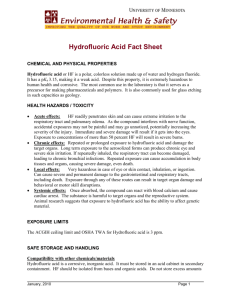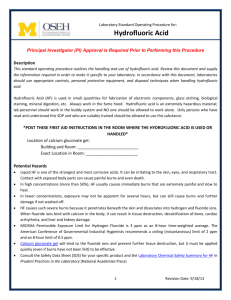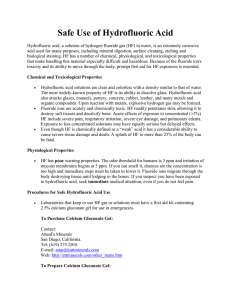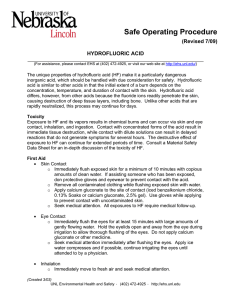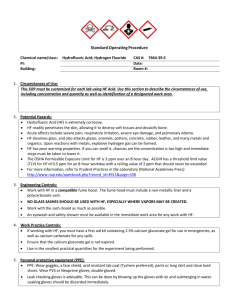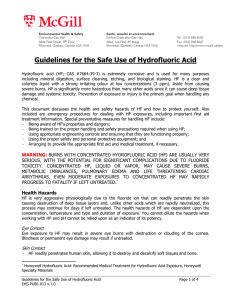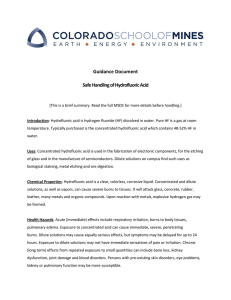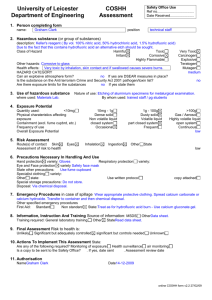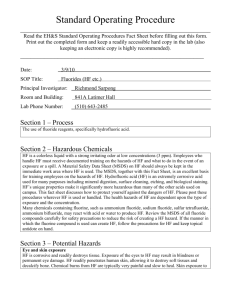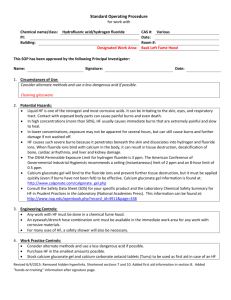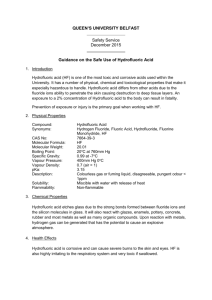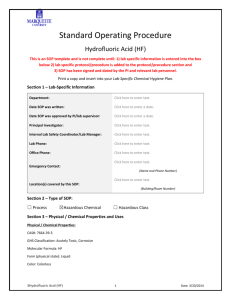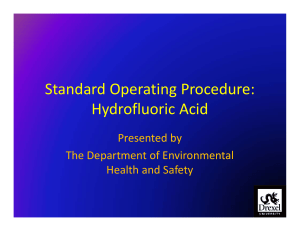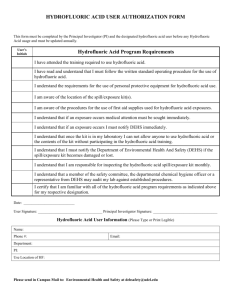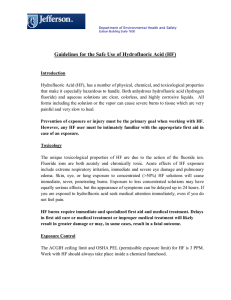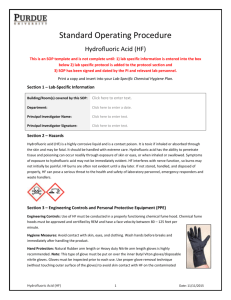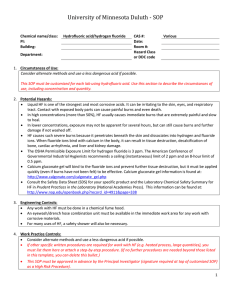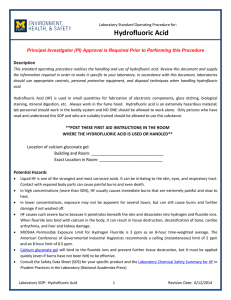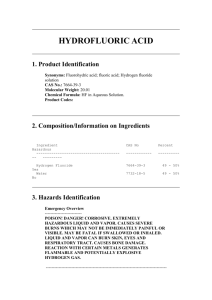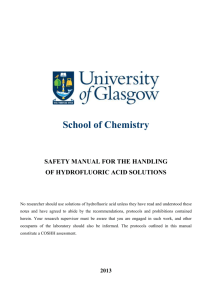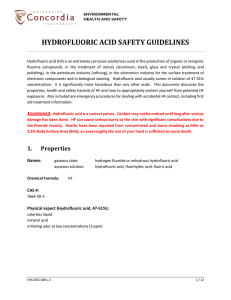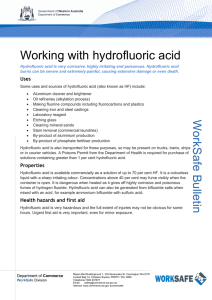Word document - Environmental Health & Safety
advertisement
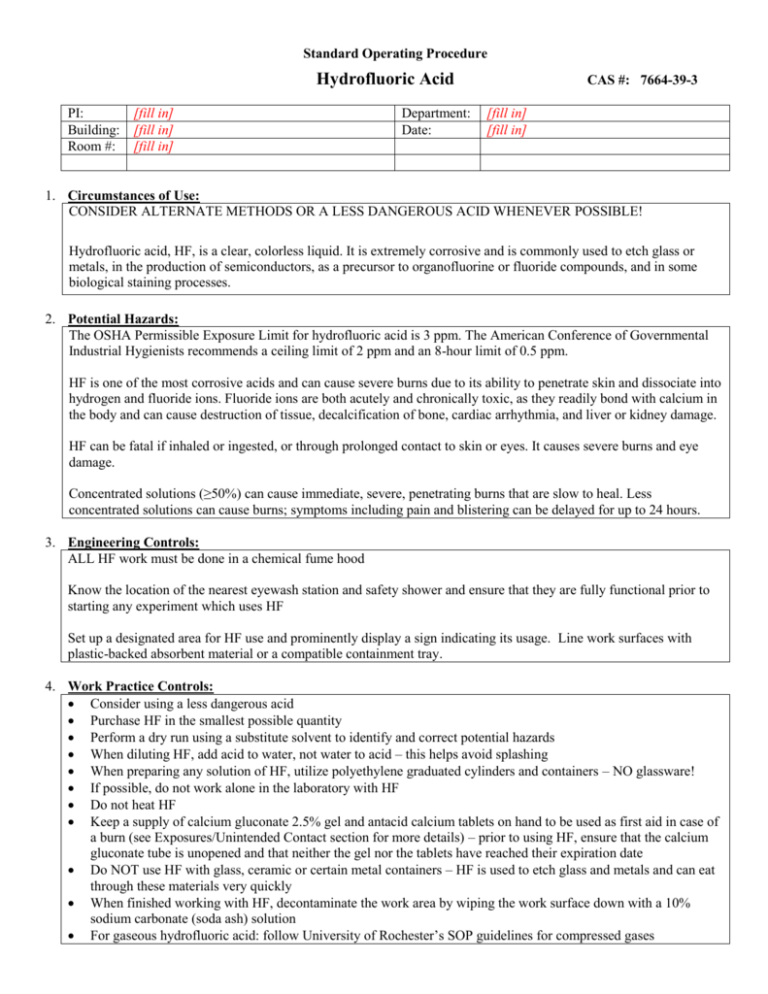
Standard Operating Procedure Hydrofluoric Acid PI: [fill in] Building: [fill in] Room #: [fill in] Department: Date: CAS #: 7664-39-3 [fill in] [fill in] 1. Circumstances of Use: CONSIDER ALTERNATE METHODS OR A LESS DANGEROUS ACID WHENEVER POSSIBLE! Hydrofluoric acid, HF, is a clear, colorless liquid. It is extremely corrosive and is commonly used to etch glass or metals, in the production of semiconductors, as a precursor to organofluorine or fluoride compounds, and in some biological staining processes. 2. Potential Hazards: The OSHA Permissible Exposure Limit for hydrofluoric acid is 3 ppm. The American Conference of Governmental Industrial Hygienists recommends a ceiling limit of 2 ppm and an 8-hour limit of 0.5 ppm. HF is one of the most corrosive acids and can cause severe burns due to its ability to penetrate skin and dissociate into hydrogen and fluoride ions. Fluoride ions are both acutely and chronically toxic, as they readily bond with calcium in the body and can cause destruction of tissue, decalcification of bone, cardiac arrhythmia, and liver or kidney damage. HF can be fatal if inhaled or ingested, or through prolonged contact to skin or eyes. It causes severe burns and eye damage. Concentrated solutions (≥50%) can cause immediate, severe, penetrating burns that are slow to heal. Less concentrated solutions can cause burns; symptoms including pain and blistering can be delayed for up to 24 hours. 3. Engineering Controls: ALL HF work must be done in a chemical fume hood Know the location of the nearest eyewash station and safety shower and ensure that they are fully functional prior to starting any experiment which uses HF Set up a designated area for HF use and prominently display a sign indicating its usage. Line work surfaces with plastic-backed absorbent material or a compatible containment tray. 4. Work Practice Controls: Consider using a less dangerous acid Purchase HF in the smallest possible quantity Perform a dry run using a substitute solvent to identify and correct potential hazards When diluting HF, add acid to water, not water to acid – this helps avoid splashing When preparing any solution of HF, utilize polyethylene graduated cylinders and containers – NO glassware! If possible, do not work alone in the laboratory with HF Do not heat HF Keep a supply of calcium gluconate 2.5% gel and antacid calcium tablets on hand to be used as first aid in case of a burn (see Exposures/Unintended Contact section for more details) – prior to using HF, ensure that the calcium gluconate tube is unopened and that neither the gel nor the tablets have reached their expiration date Do NOT use HF with glass, ceramic or certain metal containers – HF is used to etch glass and metals and can eat through these materials very quickly When finished working with HF, decontaminate the work area by wiping the work surface down with a 10% sodium carbonate (soda ash) solution For gaseous hydrofluoric acid: follow University of Rochester’s SOP guidelines for compressed gases 5. Personal protective equipment (PPE): PPE is critical when working with HF. Ensure that all PPE is fully functional with no tears or holes prior to use. Any contaminated PPE should be discarded and disposed of properly. Eye/face protection: use tightly fitting safety goggles and a face shield Skin protection: for small amounts of dilute HF solutions, double nitrile gloves can be used but should be changed immediately after use or if splashed/contaminated. For larger volumes, longer work periods, or concentrated solutions use neoprene outer gloves and nitrile inner gloves. Body protection: fully buttoned laboratory coat that completely covers the arms, long pants, close-toed shoes and a rubber apron 6. Transportation and Storage: Liquid hydrofluoric acid should be stored in a compatible primary container (preferably polyethylene) within a secondary container to capture any leaks or spills. It should be stored with other inorganic acids, away from bases and other incompatible materials including metals. It should not be stored under the sink or on the floor. Containers should be kept tightly closed and should be carefully resealed when HF is no longer in use. Store containers in their upright position to avoid leaks. For liquid and gaseous hydrofluoric acid: store below eye level in a well ventilated area away from all incompatible materials. When transporting HF, do so in secondary containment, preferably a polyethylene or other non-reactive solvent bottle carrier. 7. Waste Disposal: Follow University of Rochester guidelines for the accumulation and storage of hazardous waste. DO NOT store hydrofluoric acid waste in an incompatible container. Be sure to use a polyethylene container for HF waste storage. It is recommended that HF waste be collected and removed separately from other hazardous waste. Contact UofR’s Environmental Compliance for a waste pick up or for further information (x5-2056) 8. Exposures/Unintended contact: Seek immediate medical attention if HF exposure occurs by calling x5-2662 for University Health Services. Keep a hard copy of Environmental Health and Safety’s Hydrofluoric Acid Emergency Procedure or the SDS to give to medical personnel to clearly indicate a hydrofluoric acid (not hydrochloric) exposure has occurred. Anyone assisting a person who has been exposed to HF must also wear appropriate PPE to avoid cross contamination. In case of skin exposure: Remove contaminated clothing, shoes, and PPE immediately then rinse skin with water under a safety shower for at least fifteen minutes. After decontamination with water, further damage can still occur due to the rapid penetration of fluoride ions. Treat the exposed area by applying a topical 2.5% calcium gluconate gel. If possible, the exposed person should perform this task themselves (while wearing gloves) to avoid contamination of others. Repeat treatment until burning ceases, reapplying gel every fifteen minutes and keeping track of the time. Seek immediate medical attention at Strong Memorial Hospital Emergency Department, and inform medical personnel of the exact nature of the burn. In case of eye exposure: Flush eyes with water for a minimum of fifteen minutes and immediately seek medical attention. Continue to rinse eyes during transport to. If inhaled: Move exposed person to fresh air and keep in a resting position for comfortable breathing. Seek immediate medical attention at Strong Memorial Hospital Emergency Department. If ingested: Rinse mouth with copious amounts of water and DO NOT induce vomiting. If the victim is conscious, administer a calcium- or magnesium-containing antacid supplement. Do not give an unconscious person anything by mouth. Seek immediate medical attention at Strong Memorial Hospital Emergency Department. An incident report should be filed within 24 hours. Employee Incident Report forms can be found at: http://www.safety.rochester.edu/SMH115.html Follow-up medical attention should be sought through the University Health Services 9. Spill Procedure: Small spills (fewer than 50 mL of liquid hydrofluoric acid within a chemical fume hood) can be absorbed using magnesium sulfate, soda lime, sodium carbonate or any other spill absorbent specific to HF. DO NOT use organic spill kits which may contain Floor-Dri, kitty litter, or sand because HF reacts with silica to produce silicon tetrafluoride which is a toxic gas. Decontaminate the area after spill is cleaned up with a 10% sodium carbonate solution. For larger spills or any spill which occurs outside a chemical fume hood, evacuate the area and contact Public Safety (x13) who will then contact Environmental Health and Safety’s Spill Team. Be available for EH&S should they have any questions regarding the spill. 10. Training of personnel: All personnel are required to complete the online General Lab Safety session either in-person or on-line. The user must demonstrate competency and familiarity regarding the safe handling and use of hydrofluoric acid prior to purchase. Training should include review of: Current manufacturer SDS OSHA Lab Standard University of Rochester’s Chemical Hygiene Plan EH&S’s HF Safety Procedures and HF Emergency Procedure Training on lab-specific procedures and the hazards of HF, including the use of calcium gluconate gel, is required for all personnel working with these materials, and must be documented (topics covered, date, employee names and signatures). All personnel shall read and fully adhere to the laboratory-specific SOP, and shall document that they have read it by signing and dating the SOP. “I have read and understand this SOP. I agree to fully adhere to its requirements.” Last First Signature Date
